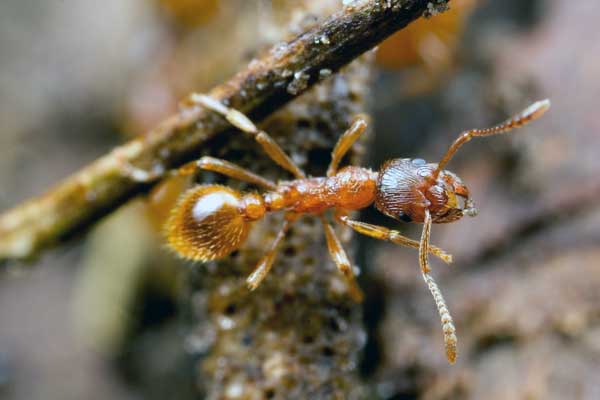
European fire ants team up with invasive plant species to alter North American ecosystems
Published: January 6, 2015
An invasive ant species that has become increasingly abundant in eastern North America not only takes over yards and delivers a nasty sting, it’s helping the spread of an invasive plant species.
The ants are so effective at dispersering invasive plant seeds that new research suggests this combination of seed and ant could wreak havoc on native ecosystems.
University of Toronto researchers have found that the European fire ant, Myrmica rubra, disperses seeds of both native and invasive plants, but it does a much better job of helping an invasive plant to spread.
“Ecologists think invasive species might help each other to spread, but there are few good examples. They talk about ‘invasional meltdown,’ because ecosystems could be very, very rapidly taken over by invasive species if invaders help each other out,” said evolutionary biologist Megan Frederickson, one of the authors of the study, published December 24 in the journal Proceedings of the Royal Society B.
“Our results suggest that invasional meltdown could be happening right under our noses, here in Ontario.”
The research was conducted at U of T’s field station, the Koffler Scientific Reserve at Jokers Hill. The team created artificial ecological communities – mesocosms – inside 42 small plastic children’s swimming pools.
Researchers filled each pool with soil and planted four species of spring wildflowers – three native species (sharp-lobed hepatica, Canadian wild ginger and bloodroot) and one invasive species: greater celandine. They then collected colonies of either the European fire ant or a native woodland ant and added the colonies to the pools. The ants picked up and moved seeds of these plant species and the researchers watched what happened.
“The pools with the invasive ant were overrun by the invasive plant, but pools with the native ant had lots of native plants,” said co-author and ecologist Kirsten Prior.
The invasive ant moved lots of seeds of all four plant species, but the invasive plant took advantage of being dispersed more than the other species and recruited in very large numbers.
“Unfortunately, as a result of humans rapidly moving species around the globe through trade and traffic, most ecosystems are now home to numerous invasive species,” said Prior. “Our finding that multiple invasive species can accelerate invasion and cause ecosystems to become dominated by invasive species is a troubling one. Invasive species are a leading threat to natural ecosystems, and can have impacts on society.
“Research on how ecosystems become invaded and the consequences of invasion is important. It sets us on the right path to develop solutions to reduce the spread and impact of these harmful species.”
Other research team members included undergraduate students Jennifer Robinson and Shannon Meadley Dunphy. Research was funded by the Natural Sciences and Engineering Research Council and the Ontario Ministry of Economic Development and Innovation.
Pictured below: U of T's field station, Koffler Scientific Reserve, with its ant-plant mecososms - kiddie pools filled with soil containing artificial communities of common native woodland plants, an invasive woodland plant, and either colonies of the invasive European fire ant or a native woodland ant that is a "keystone disperser" of seeds of native plants in Ontario forests. (Photo by K. M. Prior)




